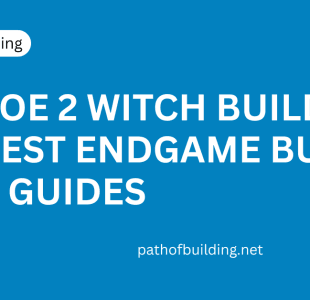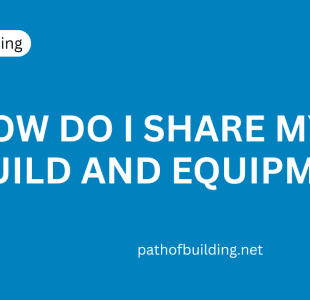The 4 Stages of Path of Building (PoB)
Introduction
Path of Building (PoB) is a powerful offline tool for Path of Exile, an action RPG known for its complex character builds. For veterans of Path of Exile, Path of Building becomes an essential companion. But the learning curve for PoB can be daunting.
There’s a humorous meme circulating online that captures the experience of 4 Stages of Path of Building users in four stages. Let’s dive into what those stages might be..

Setting Up Your Build in Path of Building (PoB)
PathofBuilding (PoB) offers a robust system for planning and optimizing your character in Path of Exile. Here’s a detailed breakdown of the initial steps in setting up your build:
Character Selection and Basic Information:
Ascendancy Class:
This is the foundation of your build, defining your character’s starting passive skill points and Ascendancy skill tree access. Choose from a variety of Ascendancies within each core class (Witch, Shadow, Templar, etc.), each offering unique playstyle options.
Bandits:
Select which bandits you’ll encounter in the campaign. These encounters offer permanent passive skill point rewards, with different choices catering to specific build goals.
Name and Level:
Define your character’s name and their current level (or target level for planning).
Skills and Link Setup:
Main Skill Gem: This is the core skill your character will use for dealing damage, casting spells, or utility. Choose a gem that aligns with your desired playstyle and class synergy.
Support Gems: These gems enhance your main skill, modifying its behavior, damage type, or utility. Experiment with different combinations to achieve your desired effects. Link up to six support gems to your main skill, each influencing the overall functionality.
Active Skills: Select additional skills for movement, utility, buffs, or curses. Consider skills that complement your main skill or address weaknesses, like movement skills for better positioning or defensive auras.
Gearing (including influences and crafting):
- Item Selection: Equip your character with gear that supports your build goals. This involves considering item bases (weapons, armor pieces, accessories) with desired stats, links, and implicit modifiers. Use PoB’s extensive item database to search and filter for optimal pieces.
- Influences: Delve into the complexities of endgame items with Elder, Shaper, and Crusader influences. These offer powerful modifiers that can significantly impact your build’s potential. Use PoB’s filters and options to explore influenced items and their effects.
- Crafting: Explore the crafting system within PoB. You can simulate the use of crafting currencies to modify existing items, potentially rolling specific desired stats or enhancing existing ones. This helps visualize potential upgrades and plan your resource allocation.
Additional Tips:
- Utilize PoB’s official documentation and the Path of Building community resources for in-depth explanations on each section, fostering better understanding and collaboration.
- Many online build guides include importable PoB configurations. This allows you to quickly load a build’s setup and experiment with modifications.
- Don’t be afraid to experiment! PoB allows for a safe space to test different skill combinations, gear setups, and crafting options before committing resources in the actual game.
By following these steps and referencing available resources, you can effectively set up your build in Path of Building, paving the way for a successful and optimized character in Path of Exile.
Optimizing Damage in Path of Building (PoB)
Maximizing your character’s damage output is key in Path of Exile, and the use of Path of Building (PoE) tools helps analyze, optimize, and perfect your build seamlessly. Here’s how to utilize PoB for damage optimization:
Understanding DPS (Damage per Second) Calculation:
- PoB’s Calculations: PoB automatically calculates your character’s DPS based on your skills, gear, and passive tree selections. This includes factoring in various damage modifiers, attack speed, critical strike chance/damage, and more.
- Understanding Modifiers: Familiarize yourself with the different damage modifiers in Path of Exile. These include increased damage, added damage, elemental penetration, critical strike modifiers, and more. PoB displays these modifiers and their impact on your overall DPS.
- Break down the DPS: Utilize the detailed breakdown provided by PoB. This allows you to identify which skills and damage sources contribute most to your overall DPS. Analyze where your damage comes from (attacks, spells, DoTs) and prioritize areas for improvement.
Utilizing the DPS Overlay in PoB:
- Live DPS Feedback: PoB offers a DPS overlay feature that can be used in-game with Path of Exile. This overlay displays your character’s real-time DPS while you’re playing.
- Testing Scenarios: Use the overlay to test the impact of different gear pieces, skill setups, and passive tree adjustments. This allows you to see the immediate effect on your DPS before committing changes in Path of Exile.
- Enemy Selection: Configure the overlay to simulate damage against different enemy types. This helps you optimize your build for specific encounters, like bosses with high elemental resistances or hordes of trash mobs.
Adjusting Gear and Skills for Maximum Damage:
Identify Bottlenecks: Analyze PoB’s detailed breakdown to identify areas where your damage can be improved. Look for low damage modifiers, lack of synergy between skills and gear, or inefficient passive skill selections.
Prioritize Upgrades: Consider which gear upgrades offer the most significant DPS increase for your resources. Look for items with high base damage rolls, desired mods like increased elemental damage or critical strike chance, and synergies with your build’s core mechanics.
Passive Tree Optimization: Review your passive skill tree selections. Consider respeccing points to invest in nodes that offer more damage per point or better synergize with your chosen skills and gear.
Balance Considerations: While maximizing DPS is important, don’t neglect other essential aspects like survivability or mana regeneration. Aim for a balance that allows you to deal damage efficiently while staying alive in challenging encounters.
Additional Tips:
- Utilize community resources and build guides for insights on popular damage scaling methods for your chosen Ascendancy class and skill.
- Experiment with different combinations of support gems and auras to see how they impact your overall damage output and utility.
- Remember, Path of Exile isn’t just about raw DPS. Consider factors like clear speed, single-target damage, and survivability when optimizing your build.
Refining Other Stats in Path of Building (PoB)
While damage output is crucial in Path of Exile, a well-rounded character requires attention to other vital stats. Path of Building (PoB) provides tools to analyze and optimize your build beyond pure DPS. Here’s how to refine other important stats:
Considering Survivability (Life, Defense):
Life Total: Analyze your character’s total life pool. Aim for a sufficient amount of life to withstand encounters with your chosen difficulty level. PoB displays your Effective Hit Pool (EHP), which factors in damage reduction from armor, evasion, and other defensive mechanics.
Defense Layers: Path of Exile offers multiple layers of defense: Armor mitigates physical damage, Evasion allows you to dodge attacks, and Energy Shield absorbs elemental damage. Consider investing in a combination of these defensive layers based on your chosen playstyle and the threats you’ll face.
Regeneration and Recovery: Don’t neglect life regeneration, Energy Shield recharge, or guard skills that offer temporary damage mitigation. PoB shows your character’s life and Energy Shield regeneration rates, helping you assess your survivability over time.
Mana Management and Efficiency:
- Mana Pool: Ensure you have enough mana to comfortably cast your chosen skills. Consider investing in mana nodes on the passive tree or using gear with increased mana or reduced mana cost modifiers.
- Mana Regeneration: Analyze your mana regeneration rate and consider ways to improve it. This might involve using gear or passive tree nodes with increased mana regeneration, using a mana flask, or utilizing skills that generate mana on hit.
- Mana Efficiency: Look for ways to reduce your skills’ mana cost. This can be achieved through support gems like “Reduced Mana Cost,” specific passive tree nodes, or using quality gems that inherently have lower mana costs.
Utility Stats (Movement Speed, Resistances):
- Movement Speed: Movement speed significantly impacts your gameplay experience. Invest in gear or passive tree nodes that offer increased movement speed to improve your mobility and clear speed.
- Resistances: All characters in Path of Exile have elemental resistances (Fire, Cold, Lightning) that reduce incoming elemental damage. Aim to have a high resistance rating (ideally capped at 75% for each element) to mitigate elemental damage effectively. Use PoB to identify gear and passive tree points that contribute to your resistances.
- Other Utility Stats: Other valuable utility stats include accuracy (for hit-based builds), critical strike chance (for builds that rely on critical hits), and ailment avoidance (to avoid elemental ailments like ignite, freeze, or shock). Use PoB to assess these stats and invest in them if they contribute to your build’s overall effectiveness.
Additional Tips:
- Utilize tools like PoB’s “Effective DPS” metric, which considers both damage output and survivability to gauge your character’s overall combat effectiveness.
- Consider the specific content you’ll be tackling. Optimizations for endgame bosses may differ from those needed for clearing maps efficiently.
- Balance is key. Strive to achieve a character build with sufficient damage output, survivability, mana management, and utility stats to progress comfortably in Path of Exile.
Conclusion
4 Stages of Path of Building (PoB) offers a powerful and versatile toolset for Path of Exile players. By following the steps outlined above, you can leverage PoB to:
- Craft a Strong Foundation: Set up your character’s core mechanics, including skills, gear selection, and basic information.
- Optimize Damage Output: Understand DPS calculations, utilize the DPS overlay, and strategically adjust gear and skills to maximize your character’s damage potential.
- Refine Other Stats: Ensure survivability through sufficient life and defenses, manage mana efficiently, and invest in valuable utility stats like movement speed and resistances.
Remember, PoB is a valuable companion, not a definitive guide. Experiment, utilize community resources, and find the balance that suits your playstyle and desired content in Path of Exile. With dedication and the power of PoB, you can create a well-rounded and powerful character to conquer the challenges of Wraeclast!
FAQs
How do I use the Passive Tree 4 Stages of Path of Building?
In the Passive Tree stage, players allocate skill points on the passive skill tree to optimize their build’s stats and bonuses. This stage is crucial for maximizing damage output, survivability, and utility.
What does the Gear & Skills stage entail in Path of Building?
The Gear & Skills stage involves selecting and optimizing the character’s equipment, gems, and skill gems. Players identify the best-in-slot items for their build, adjust gem setups, and fine-tune their character’s setup for optimal performance.
What is the Finalization stage in Path of Building?
The Finalization stage is where players fine-tune their build, making adjustments based on factors like budget, availability of gear, and personal preferences. This stage may involve tweaking passive tree allocations, adjusting gem links, or optimizing gear choices.
How do I progress through the four stages of Path of Building efficiently?
To progress efficiently, start by theorycrafting your build concept, then move on to allocating passive points on the passive tree. Next, focus on selecting and optimizing gear and skills before finalizing the build by refining your choices based on practical considerations and playtesting.
Can I skip any of the stages in Path of Building?
While it’s possible to skip some of the stages, such as starting directly with gear and skills if you’re following a well-documented build guide, going through each stage ensures a more comprehensive understanding of your build and better optimization.
How does Path of Building assist with each stage of the build process?
Path of Building provides tools and features to facilitate each stage of the build process. It offers a comprehensive passive skill tree planner, allows for gear and gem customization, and enables detailed DPS calculations and stat tracking to help players optimize their builds effectively.
Latest Post







Leave A Reply